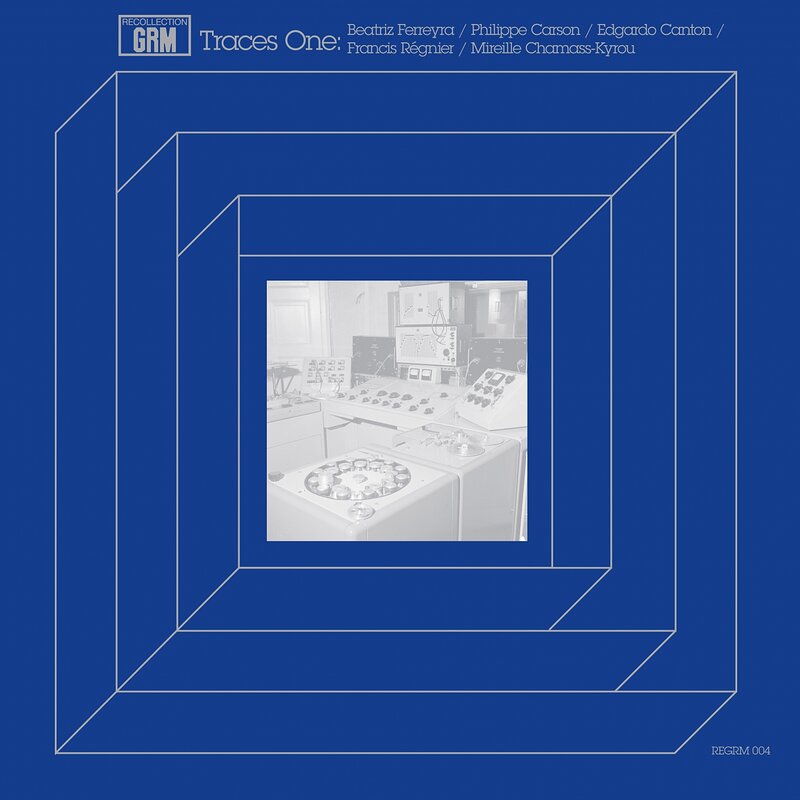Various Artists: Traces One
Fantastic, valuable reissue for the adventurous person: seminal 1960s electro-accoustic album - one NM copy
- A1 Beatriz Ferreyra: L’Orvietan
- A2 Philippe Carson: Turmac
- B1 Edgardo Canton: I Palpiti
- B2 Francis Régnier: Chemins D'avant La Mort
- B3 Mireille Chamass-Kyrou: Etude 1
Beatriz Ferreyra: L’ Orvietan (1970) Work composed of two separate movements, the first drawing from electronic sounds, the second from concrete ones. These two sources do not meet, they equally tend towards sound antagonism and a complementarity of spirit. - Philippe Carson: Turmac (1961) This work was created from the sounds of machines of the Stuyvesant factories (Holland). Three movements follow one another: first, the spell of rhythms and a build-up that gradually removes the listener from the mechanical reality. A more animated movement follows, full of contrasts. The third part is a long crescendo in terms of intensity, density and thickness, which results in a paroxysm. "The noise environment of the workplace is thus transposed, ennobled and magnified" (J. ROY.) 1961. - Edgardo Canton: I Palpiti (1966) “For some time I thought that Gaetano Donizetti had written an Aria called "I palpiti" but apparently this is not the case. Nevermind. This piece acquired an evocative value linked to the pleasure the music of this composer gives me. Just like the fervent "prima donna" donizetian choirs, anything that lives, also pulses, shivers and quivers. These are the qualities of life I have tried to convey here. (E.C.) - Francis Régnier: Chemins D’avant La Mort(1968) ’Chemins D’avant La Mort’ is one of the few works created by Francis Regnier at the GRM, where he was technical coordinator. It is a short piece, composed as a gesture, a dramatic blast stretched between two sound lines rising from and returning to silence. - Mireille Chamass: Kyrou Etude 1(1960) “Etude 1 consists in three sequences, the first two each develop a single sound object." The one that generates the first sequence is characterized by an asymmetrical crescendo-decrescendo and a material whose grain constantly fluctuates. The second sequence multiplies a sound object reduced to its attack in tiny elements divided into three zones that differentiate the overall density and size of the elements: Giant molecules, more defined constellations and fine dust sound. They gradually condense in the third sequence as a kaleidoscopic stretto".
Various Artists: Traces One
Fantastic, valuable reissue for the adventurous person: seminal 1960s electro-accoustic album - one NM copy
| Beatriz Ferreyra: L'Orvietan | 12:58 | Album onlyAlbum only |
| Philippe Carson: Turmac | 9:45 | Album onlyAlbum only |
| Edgardo Canton: I palpiti | 8:00 | Album onlyAlbum only |
| Francis Régnier: Chemins d'avant la mort | 4:21 | Album onlyAlbum only |
| Mireille Chamass-Kyrou: Etude 1 | 5:10 | Album onlyAlbum only |
Beatriz Ferreyra: L’ Orvietan (1970) Work composed of two separate movements, the first drawing from electronic sounds, the second from concrete ones. These two sources do not meet, they equally tend towards sound antagonism and a complementarity of spirit. - Philippe Carson: Turmac (1961) This work was created from the sounds of machines of the Stuyvesant factories (Holland). Three movements follow one another: first, the spell of rhythms and a build-up that gradually removes the listener from the mechanical reality. A more animated movement follows, full of contrasts. The third part is a long crescendo in terms of intensity, density and thickness, which results in a paroxysm. "The noise environment of the workplace is thus transposed, ennobled and magnified" (J. ROY.) 1961. - Edgardo Canton: I Palpiti (1966) “For some time I thought that Gaetano Donizetti had written an Aria called "I palpiti" but apparently this is not the case. Nevermind. This piece acquired an evocative value linked to the pleasure the music of this composer gives me. Just like the fervent "prima donna" donizetian choirs, anything that lives, also pulses, shivers and quivers. These are the qualities of life I have tried to convey here. (E.C.) - Francis Régnier: Chemins D’avant La Mort(1968) ’Chemins D’avant La Mort’ is one of the few works created by Francis Regnier at the GRM, where he was technical coordinator. It is a short piece, composed as a gesture, a dramatic blast stretched between two sound lines rising from and returning to silence. - Mireille Chamass: Kyrou Etude 1(1960) “Etude 1 consists in three sequences, the first two each develop a single sound object." The one that generates the first sequence is characterized by an asymmetrical crescendo-decrescendo and a material whose grain constantly fluctuates. The second sequence multiplies a sound object reduced to its attack in tiny elements divided into three zones that differentiate the overall density and size of the elements: Giant molecules, more defined constellations and fine dust sound. They gradually condense in the third sequence as a kaleidoscopic stretto".




